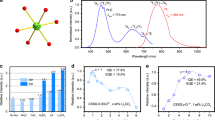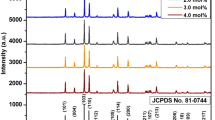Abstract
Near-infrared (NIR)-emitting phosphors are in high demand owing to their application in areas of high importance, such as security, night-surveillance, imaging, storage, and optoelectronics. However, to achieve high success in these applications, wide broadband NIR emissions are needed and, in that context, the crystalline field of the host matrix plays a very important role. In this work, we have achieved a broad NIR emission in the range of 700–1000 nm in hydrothermally synthesized SrHfO3:Cr3+ (SHOC). SHO assumes a microcrystalline cube morphology, and chromium doping make it more and more symmetric, and the particle size increases with doping. Broadband NIR emissions have been ascribed to the stabilization of Cr3+ in a strong crystalline field of HfO6 octahedra. X-ray photoelectron spectroscopy supported this by confirming the formation of oxygen vacancies in all the samples. The shorter lifetime (~13–44 µs) is attributed to chromium ions situated in close vicinity to oxygen vacancies at distance X, whereas the longer-lived (~56–127 µs) originate from chromium ions situated at a long distance from oxygen vacancies at distance Y, and Y is greater than X. Positron annihilation lifetime spectroscopy suggested an increase in defect concentration with doping, which causes concentration quenching beyond 2.0 mol% endowed by multipolar interactions. This work culminates the very important role of defects, local site, and doping on efficient NIR light emissions from a perovskite lattice.




Similar content being viewed by others

Availability of Data and Materials
All data generated or analyzed during this study are included in this published article
References
M.-P. Zhuo, X.-D. Wang, and L.-S. Liao, Recent progress of novel organic near-infrared-emitting materials. Small Sci. 2, 2200029 (2022).
B.B. Srivastava, S.K. Gupta, S. Mohan, and Y. Mao, Molten-salt-assisted annealing for making colloidal ZnGa2O4: Cr nanocrystals with high persistent luminescence. Chem. A Eur. J. 27, 11398–11405 (2021).
S.K. Gupta, K. Sudarshan, D. Chandrashekhar, A. Balhara, and M. Mohapatra, Solid solution of Cr3+ doped ZnGa2O4 and Zn2SnO4 to create cation inversion and its role on persistent deep red emission. J. Lumin. 257, 119697 (2023).
S.K. Gupta, K. Sudarshan, P. Modak, D. Chandrashekhar, M. Tyagi, B. Modak, and M. Mohapatra, Design of need-based phosphors and scintillators by compositional modulation in the ZnGa2−xAlxO4:Cr3+ spinel: pure compound versus solid solutions. Phys. Chem. Chem. Phys. 24, 23790–23801 (2022).
S.K. Gupta, K. Sudarshan, N.S. Rawat, M. Tyagi, and M. Mohapatra, Delineating the role of defect and compositions in luminescent ZnO-ZnGa2−xAlxO4:Cr3+ micro composites towards efficient photon utilization. J. Lumin. 257, 119730 (2023).
T. Maldiney, A. Bessière, J. Seguin, E. Teston, S.K. Sharma, B. Viana, A.J.J. Bos, P. Dorenbos, M. Bessodes, D. Gourier, D. Scherman, and C. Richard, The in vivo activation of persistent nanophosphors for optical imaging of vascularization, tumours and grafted cells. Nat. Mater. 13, 418–426 (2014).
S.-K. Sun, H.-F. Wang, and X.-P. Yan, Engineering persistent luminescence nanoparticles for biological applications: from biosensing/bioimaging to theranostics. Acc. Chem. Res. 51, 1131–1143 (2018).
C.T. Jackson, S. Jeong, G.F. Dorlhiac, and M.P. Landry, Advances in engineering near-infrared luminescent materials. Iscience 24, 102156 (2021).
P. Dang, Y. Wei, D. Liu, G. Li, and J. Lin, Recent advances in chromium-doped near-infrared luminescent materials: fundamentals. Optim. Strateg. Appl. Adv. Opt. Mater. 11, 2201739 (2023).
S.K. Gupta, K. Sudarshan, B. Modak, and R. Gupta, Interstitial zinc boosted light tunability, afterglow, and ultrabright white emission in zinc germanate (Zn2GeO4). ACS Appl. Electron. Mater. 5, 1286–1294 (2023).
L.K. Bharat, S.-K. Jeon, K.G. Krishna, and J.S. Yu, Rare-earth free self-luminescent Ca2KZn2(VO4)3 phosphors for intense white light-emitting diodes. Sci. Rep. 7, 42348 (2017).
I.V. Berezovskaya, V.P. Dotsenko, A.S. Voloshinovskii, and S.S. Smola, Near infrared emission of Eu2+ ions in Ca3Sc2Si3O12. Chem. Phys. Lett. 585, 11–14 (2013).
Z. Yang, Y. Zhao, Y. Zhou, J. Qiao, Y.-C. Chuang, M.S. Molokeev, and Z. Xia, Giant red-shifted emission in (Sr, Ba)Y2O4:Eu2+ phosphor toward broadband near-infrared luminescence. Adv. Func. Mater. 32, 2103927 (2022).
Y. Zhu, X. Wang, J. Qiao, M.S. Molokeev, H.C. Swart, L. Ning, and Z. Xia, regulating Eu2+ multisite occupation through structural disorder toward broadband near-infrared emission. Chem. Mater. 35, 1432–1439 (2023).
O.S. Wenger, and H.U. Güdel, Optical spectroscopy of CrCl63− doped Cs2NaScCl6: broadband near-infrared luminescence and Jahn–Teller effect. J. Chem. Phys. 114, 5832–5841 (2001).
Q. Zhang, D. Liu, P. Dang, H. Lian, G. Li, and J. Lin, Two Selective sites control of Cr3+-doped ABO4 phosphors for tuning ultra-broadband near-infrared photoluminescence and multi-applications. Laser Photonics Rev. 16, 2100459 (2022).
F. Zhao, Z. Song, J. Zhao, and Q. Liu, Double perovskite Cs2AgInCl6:Cr3+: broadband and near-infrared luminescent materials. Inorg. Chem. Front. 6, 3621–3628 (2019).
B.B. Srivastava, S.K. Gupta, and Y. Mao, Remarkable enhancement of photoluminescence and persistent luminescence of NIR emitting ZnGa2O4:Cr3+ nanoparticles. CrystEngComm 22, 2491–2501 (2020).
H. Hua, J. Ueda, J. Xu, M. Back, and S. Tanabe, High-pressure photoluminescence properties of Cr3+-doped LaGaO3 perovskites modulated by pressure-induced phase transition. Inorg. Chem. 60, 19253–19262 (2021).
S.K. Gupta, P.S. Ghosh, N. Pathak, A. Arya, and V. Natarajan, Understanding the local environment of Sm3+ in doped SrZrO3 and energy transfer mechanism using time-resolved luminescence: a combined theoretical and experimental approach. RSC Adv. 4, 29202–29215 (2014).
S.K. Gupta, P.S. Ghosh, A.K. Yadav, N. Pathak, A. Arya, S.N. Jha, D. Bhattacharyya, and R.M. Kadam, Luminescence properties of SrZrO3/Tb3+ perovskite: host-dopant energy-transfer dynamics and local structure of Tb3+. Inorg. Chem. 55, 1728–1740 (2016).
S.K. Gupta, and Y. Mao, A review on molten salt synthesis of metal oxide nanomaterials: status, opportunity, and challenge. Prog. Mater. Sci. 117, 100734 (2021).
S.K. Gupta, K. Sudarshan, and R.M. Kadam, Optical nanomaterials with focus on rare earth doped oxide: a review. Mater. Today Commun. 27, 102277 (2021).
L. Huang, L. Lin, W. Xie, Z. Qiu, H. Ni, H. Liang, Q. Tang, L. Cao, J.-X. Meng, and F. Li, Near-Infrared persistent luminescence in a Cr3+-doped perovskite for low-irradiance imaging. Chem. Mater. 32, 5579–5588 (2020).
Y. Katayama, H. Kobayashi, and S. Tanabe, Deep-red persistent luminescence in Cr3+-doped LaAlO3 perovskite phosphor for in vivo imaging. Appl. Phys. Express 8, 012102 (2015).
Z. Sun, T. Zhou, R. Liu, X. Tang, and R.-J. Xie, Ultrawide near-infrared SrHfO3:Cr3+ phosphor with dual emission bands. J. Am. Ceram. Soc. 106, 3446–3454 (2023).
H. Fukushima, D. Nakauchi, G. Okada, T. Kato, N. Kawaguchi, and T. Yanagida, Ce concentration dependence on scintillation properties of SrHfO3 single crystals. J. Alloy. Compd. 934, 167929 (2023).
R. Zhang, Y. Jin, L. Yuan, K. Deng, C. Wang, G. Xiong, L. Chen, and Y. Hu, Inorganic photochromism material SrHfO3:Er3+ integrating multiple optical behaviors for multimodal anti-counterfeiting. J. Alloy. Compd. 921, 166081 (2022).
S.K. Gupta, M. Tyagi, and K. Sudarshan, Stabilization of UO22+ in SrHfO3 perovskite and probing defects, local structure and photo/thermoluminescence. J. Lumin. 243, 118663 (2022).
J. Kim, D. Song, H. Yun, J. Lee, J.H. Kim, J.H. Kim, B. Kim, and K. Char, Low leakage in high-k perovskite gate oxide SrHfO3. Adv. Electron. Mater. 9, 2201341 (2023).
M. Roy, S. Ghosh, and M.K. Naskar, Solvothermal synthesis of Cr2O3 nanocubes via template-free route. Mater. Chem. Phys. 159, 101–106 (2015).
T.X. Nguyen, J. Patra, J.-K. Chang, and J.-M. Ting, High entropy spinel oxide nanoparticles for superior lithiation–delithiation performance. J. Mater. Chem. A 8, 18963–18973 (2020).
D. Wang, S. Jiang, C. Duan, J. Mao, Y. Dong, K. Dong, Z. Wang, S. Luo, Y. Liu, and X. Qi, Spinel-structured high entropy oxide (FeCoNiCrMn)3O4 as anode towards superior lithium storage performance. J. Alloy. Compd. 844, 156158 (2020).
G. Bai, H. Dai, Y. Liu, K. Ji, X. Li, and S. Xie, Preparation and catalytic performance of cylinder-and cake-like Cr2O3 for toluene combustion. Catal. Commun. 36, 43–47 (2013).
T. Tan, Y. Du, Y. Sun, H. Zhang, A. Cao, and G. Zha, Resistive switching modification by ultraviolet illumination in amorphous SrO-based resistive random access memory. J. Mater. Sci. Mater. Electron. 30, 13445–13453 (2019).
N. Ohtsu, B. Tsuchiya, M. Oku, T. Shikama, and K. Wagatsuma, X-ray photoelectron spectroscopic study on initial oxidation of hafnium hydride fractured in an ultra-high vacuum. Appl. Surf. Sci. 253, 6844–6847 (2007).
T.-C. Tien, L.-C. Lin, L.-S. Lee, C.-J. Hwang, S. Maikap, and Y.M. Shulga, Analysis of weakly bonded oxygen in HfO2/SiO2/Si stacks by using HRBS and ARXPS. J. Mater. Sci. Mater. Electron. 21, 475–480 (2010).
T.P. Smirnova, L.V. Yakovkina, V.N. Kitchai, V.V. Kaichev, Y.V. Shubin, N.B. Morozova, and K.V. Zherikova, Chemical vapor deposition and characterization of hafnium oxide films. J. Phys. Chem. Solids 69, 685–687 (2008).
J. Gan, X. Lu, J. Wu, S. Xie, T. Zhai, M. Yu, Z. Zhang, Y. Mao, S.C.I. Wang, Y. Shen, and Y. Tong, Oxygen vacancies promoting photoelectrochemical performance of In2O3 nanocubes. Sci. Rep. 3, 1021 (2013).
Y. Zhuang, J. Ueda, S. Tanabe, and P. Dorenbos, Band-gap variation and a self-redox effect induced by compositional deviation in ZnxGa2O3+x:Cr3+ persistent phosphors. J. Mater. Chem. C 2, 5502–5509 (2014).
S.K. Gupta, R.M. Kadam, and P.K. Pujari, Lanthanide spectroscopy in probing structure-property correlation in multi-site photoluminescent phosphors. Coord. Chem. Rev. 420, 213405 (2020).
G. Blasse, Energy transfer between inequivalent Eu2+ ions. J. Solid State Chem. 62, 207–211 (1986).
Acknowledgments
We acknowledge Dr. Raghunath Acharya (Head, NA&AS) and Dr. P.K. Mohapatra (Head, RCD and Associate Director, Radiochemistry and Isotope Group), BARC for their support and encouragement.
Funding
Funding was provided by the Bhabha Atomic Research Centre, Mumbai for the present study.
Author information
Authors and Affiliations
Contributions
Santosh K. Gupta conceived the problem and supervised the work, interpreted the results and wrote the main manuscript. Annu Balhara carried out the PL experiments and Shubham Shaw synthesized the materials and carried out XPS measurements. N.K. Prasad provided the lab facilities and resources for materials synthesis and XPS and supervised the work. Kathi Sudarshan contributed in PALS data collection and analysis as well as in fine tuning of the manuscript. All authors read and approved the final manuscript.
Corresponding author
Ethics declarations
Competing interests
The authors declare that they have no known competing financial interests or personal relationships that could have appeared to influence the work reported in this paper.
Ethical Approval
This declaration is “not applicable
Additional information
Publisher's Note
Springer Nature remains neutral with regard to jurisdictional claims in published maps and institutional affiliations.
Rights and permissions
Springer Nature or its licensor (e.g. a society or other partner) holds exclusive rights to this article under a publishing agreement with the author(s) or other rightsholder(s); author self-archiving of the accepted manuscript version of this article is solely governed by the terms of such publishing agreement and applicable law.
About this article
Cite this article
Gupta, S.K., Balhara, A., Shaw, S.K. et al. SrHfO3:Cr3+ Perovskite Microcubes for Rare-Earth-Free NIR-I Light Emission. J. Electron. Mater. 53, 280–287 (2024). https://doi.org/10.1007/s11664-023-10775-2
Received:
Accepted:
Published:
Issue Date:
DOI: https://doi.org/10.1007/s11664-023-10775-2



